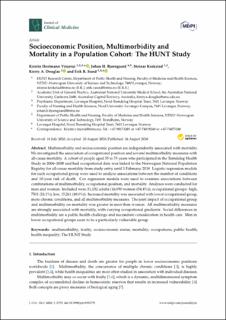| dc.contributor.author | Vinjerui, Kristin Hestmann | |
| dc.contributor.author | Krokstad, Steinar | |
| dc.contributor.author | Sund, Erik | |
| dc.contributor.author | Bjørngaard, Johan Håkon | |
| dc.date.accessioned | 2020-09-02T08:31:43Z | |
| dc.date.available | 2020-09-02T08:31:43Z | |
| dc.date.created | 2020-09-01T17:45:16Z | |
| dc.date.issued | 2020 | |
| dc.identifier.issn | 2077-0383 | |
| dc.identifier.uri | https://hdl.handle.net/11250/2675948 | |
| dc.description.abstract | Multimorbidity and socioeconomic position are independently associated with mortality. We investigated the association of occupational position and several multimorbidity measures with all-cause mortality. A cohort of people aged 35 to 75 years who participated in the Trøndelag Health Study in 2006–2008 and had occupational data was linked to the Norwegian National Population Registry for all-cause mortality from study entry until 1 February 2019. Logistic regression models for each occupational group were used to analyze associations between the number of conditions and 10-year risk of death. Cox regression models were used to examine associations between combinations of multimorbidity, occupational position, and mortality. Analyses were conducted for men and women. Included were 31,132 adults (16,950 women (54.4%)); occupational groups: high, 7501 (24.1%); low, 15,261 (49.0%)). Increased mortality was associated with lower occupational group, more chronic conditions, and all multimorbidity measures. The joint impact of occupational group and multimorbidity on mortality was greater in men than women. All multimorbidity measures are strongly associated with mortality, with varying occupational gradients. Social differences in multimorbidity are a public health challenge and necessitate consideration in health care. Men in lower occupational groups seem to be a particularly vulnerable group. | en_US |
| dc.language.iso | eng | en_US |
| dc.publisher | MDPI | en_US |
| dc.rights | Navngivelse 4.0 Internasjonal | * |
| dc.rights.uri | http://creativecommons.org/licenses/by/4.0/deed.no | * |
| dc.title | Socioeconomic position, multimorbidity and mortality in a population cohort, the HUNT Study | en_US |
| dc.type | Peer reviewed | en_US |
| dc.type | Journal article | en_US |
| dc.description.version | publishedVersion | en_US |
| dc.source.journal | Journal of Clinical Medicine | en_US |
| dc.identifier.doi | 10.3390/jcm9092759 | |
| dc.identifier.cristin | 1826589 | |
| dc.description.localcode | © 2020 by the authors. Licensee MDPI, Basel, Switzerland. This article is an open access article distributed under the terms and conditions of the Creative Commons Attribution (CC BY) license (http://creativecommons.org/licenses/by/4.0/). | en_US |
| cristin.ispublished | true | |
| cristin.fulltext | postprint | |
| cristin.qualitycode | 1 | |

